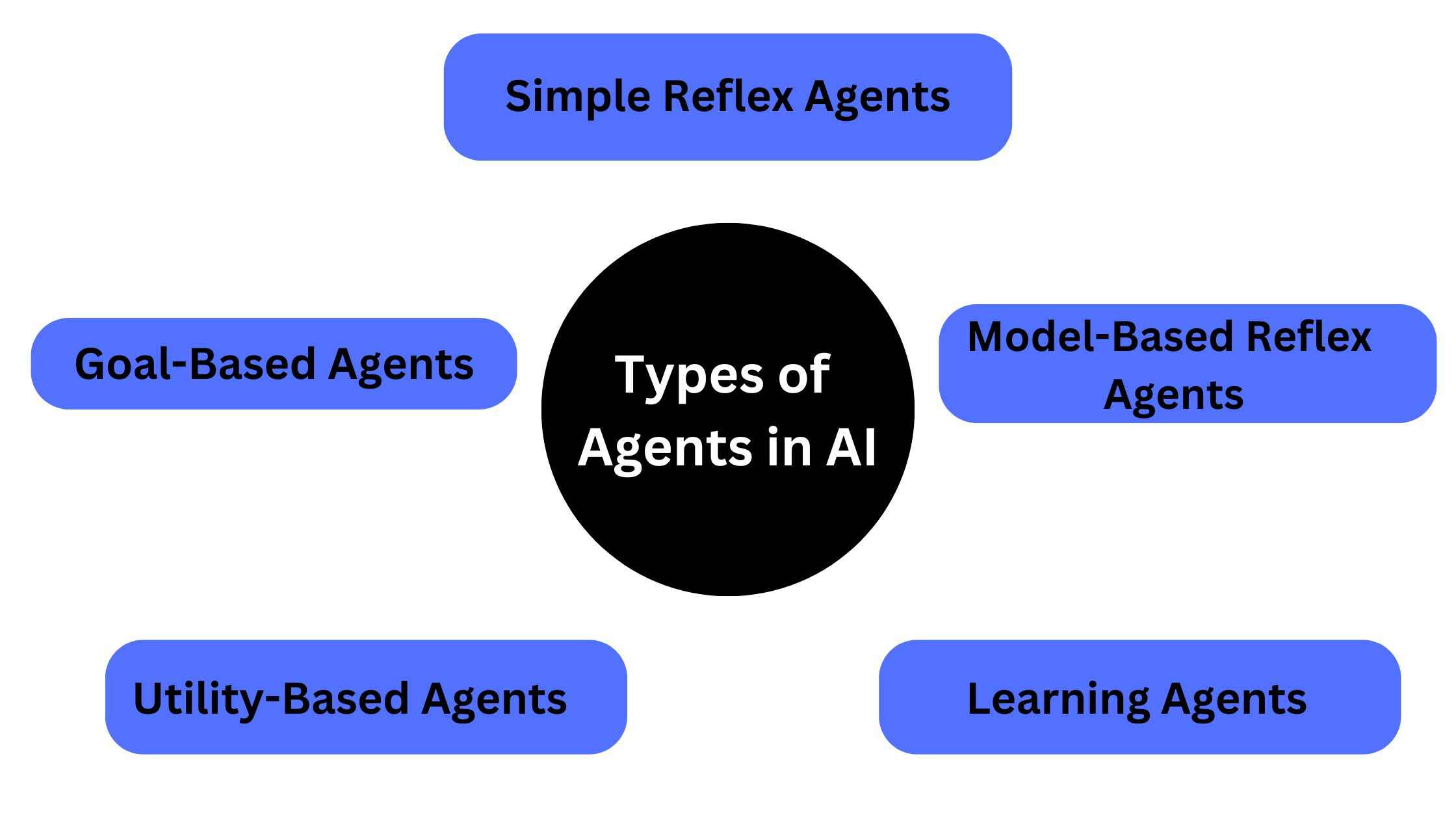Have you ever wondered about the different types of agents in AI? As artificial intelligence continues to advance, it’s important to understand the various agents that power these systems.
Types of agents in AI include simple reflex (react to stimuli), model-based (track environment), goal-based (consider future actions), utility-based (make value decision), and learning agents (improve over time).
In this blog, we will explore these types of agents in AI with their definition, examples, strengths, and their limitations. Let’s explore!
Table of Contents
- 1. Simple Reflex Agents
- 2. Model-Based Reflex Agents
- 3. Goal-Based Agents
- 4. Utility-Based Agents
- 5. Learning Agents
- FAQ’s
- Conclusion
1. Simple Reflex Agents
The most basic type of agent in AI is the simple reflex agent. These agents act solely based on the current situation and predetermined rules or condition-action rules. They don’t have any memory or model of the world.
For example, a simple reflex agent controlling a robot vacuum cleaner may have rules like “if there’s dirt, move towards it and turn on the vacuum” or “if there’s an obstacle, move around it.”
Strengths:
- Fast and efficient for basic, predetermined situations
- Simple to design and implement
- Don’t require modeling the entire environment
Limitations:
- Cannot handle complex environments or plan ahead
- Completely reactive, with no memory or foresight
- Brittle and inflexible beyond specific rules
2. Model-Based Reflex Agents
Unlike simple reflex agents, model-based reflex agents have a model of how the world works. This knowledge base or model is used to identify how their actions will affect the future.
A model-based agent for a self-driving car would have a model of traffic laws, sensors for detecting obstacles, and map data. It uses this model to identify the best routes and responses to situations.
Strengths:
- More flexible than simple reflex agents
- Can anticipate the effects of actions using their world model
- Accounts for current percepts and environment state
Limitations:
- Still fundamentally reactive and present-focused
- Building accurate world models can be difficult
- No way to handle uncertainties or plan for the future
3. Goal-Based Agents
Goal-based agents take the idea of modeling the world a step further. Not only do they have information about the current state and how their actions will affect it, but they also have goals or desired outcomes they aim for.
A goal-based agent for a game like chess would have the goal of wanting to checkmate the opponent’s king. It considers future scenarios and plans a sequence of moves to accomplish this goal.
Strengths:
- Can plan sequences of actions to achieve goals
- Factor in future scenarios during decision-making
- More proactive and intentional behavior
Limitations:
- Depend heavily on the quality of information and search algorithms
- Don’t account for uncertainty or conflicting preferences
- Can get stuck with problematic or uncertain goal selection
4. Utility-Based Agents
Utility-based agents are among the most flexible types of agents in AI. Instead of having a single goal, they aim to maximize their utility or measure of performance based on the preferences programmed by the designers.
For a utility-based trading agent, the utility could be a weighted combination of risk, profit, market share, and other factors. It will reason about uncertain outcomes to choose the actions that maximize its expected utility.
Strengths:
- Can weigh multiple competing preferences/utilities
- Reason about uncertain outcomes/environments
- Highly flexible decision-making approach
Limitations:
- Utility function design is complex and subjective
- It may be computationally expensive for real-time environments
- An unclear decision-making process can reduce transparency
5. Learning Agents
The final major type is learning agents, which can become smarter through experience in their environments. Unlike the previous agents which follow coded rules and models, learning agents use observations to learn how to modify their behaviors to achieve better performance.
A learning agent playing a video game would start with basic skills, but through trial-and-error and feedback signals like rewards, it learns strategies that allow it to keep improving.
Strengths:
- Can autonomously improve and adapt over time
- Learn from experience and environmental feedback
- Powerful using modern machine learning techniques
Limitations:
- Require extensive training data and environments
- Opaque learned behavior can be unpredictable
- Potential for learning unintended behaviors or biases
FAQ’s
There are five main types of agents in AI: simple reflex agents, model-based reflex agents, goal-based agents, utility-based agents, and learning agents.
AI agents are used to perform tasks that would be difficult, tedious, or impossible for humans. They can work tirelessly, process large amounts of data, and make decisions quickly.
The role of an agent in AI is to perceive its environment through sensors and take actions that maximize its chance of success toward an intended goal or desired outcome.
Conclusion
In conclusion, there are several key types of agents in AI, each with its own strengths and limitations. From basic reactive agents to complex learning agents, understanding these different architectures is crucial for developing effective AI systems.
As AI continues advancing, the role of intelligent agents in perceiving environments and making decisions will only become more important. Grasping the capabilities of reflex, model-based, goal-based, utility-based, and learning agents provides a solid foundation for further exploration into this exciting field.


2 thoughts on “5 Key Types of AI Agents: Reflex, Goal-Based, and Learning”